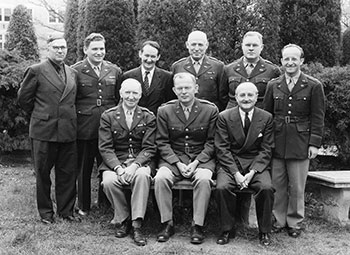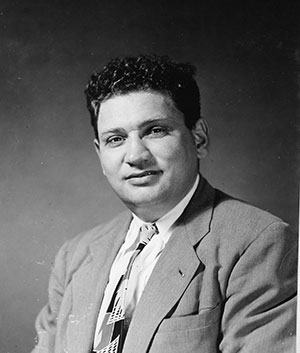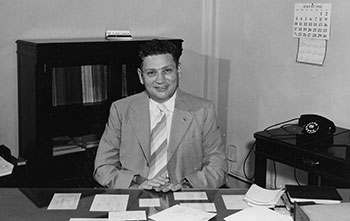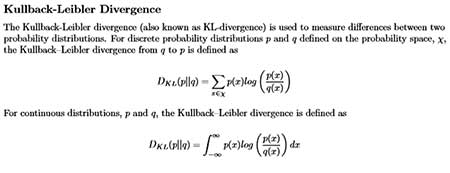The Secret Career of Solomon Kullback
Solomon Kullback, co-developer of the Kullback-Leibler divergence, began his career as a high-school mathematics teacher and concluded it as a professor at George Washington University. For more than three decades in between, he served his country as a pioneering cryptanalyst. This is the story of Kullback’s years of silent and secret government service.
Early Life and Career
Solomon Kullback was the son of Russian immigrants to the United States. It is easy to learn about his early life from Kullback himself, thanks to an oral history conducted in 1982:
I was born in Brooklyn, East New York, third of April 1907. I went to PS 149, which had quite a number of interesting graduates. I went to Boy’s High School and then to City College, and in City College, I majored in mathematics with the idea of teaching in the high schools. I actually did start teaching. I taught [at] Boy’s High, [in] mathematics …
Within a few years, Kullback found himself disillusioned with teaching. This may be why he was so receptive to an idea posed by his friend and colleague, Abraham Sinkov, in early 1930:
Abe Sinkov turned up one day. He and I had gone to high school together, we went to City College together, so we’ve been associated for quite a long time now. He came up with an announcement, a Civil Service flyer, for an examination for a mathematician in the U.S. Government. … he wasn’t too happy with the high school teaching[;], neither was I. We were both interested in mathematics, more or less using it rather than teaching it to kids who aren’t interested in learning anything. So we took the examination, both of us.
To understand the impetus behind this hiring advertisement, it’s necessary to look at what was happening in a new field: modern American cryptology.
Early American Cryptology
Making and breaking codes and ciphers were long-established practices; however, the convergence of several relatively new technologies by the early decades of the 20th century was to become a game-changer. The inventions and widespread usage of the telegraph, Morse code, radio, and undersea cables dramatically extended communications distances, even as they reduced the time factor. No longer was it necessary to await the arrival of the courier or the ship to receive news or information from a distance. One’s own—or, under the right conditions, an adversary’s—communications could be sent and received in relatively convenient ways that would have been unthinkable not many decades earlier.
In the United States, civilian and military entities alike were giving attention to protecting their own communications (cryptography) and obtaining and understanding those of others (cryptanalysis). Together, these two disciplines—often thought of as two sides of the same coin—merged into the overarching field that came to be known as cryptology.
Among early American cryptologic pioneers, none had more influence on the emerging discipline than William Friedman, a Russian immigrant whose family brought him to the USA in 1891 as a toddler. While employed as a geneticist by Riverbank Laboratories, a private research establishment, Friedman soon became enamored with the discipline of cryptology, as well as the woman who introduced him to it. Friedman married Elizebeth Smith, an English major studying Baconian codes at Riverbank, and together, they became one of American cryptology’s first power couples.
In 1921, the Friedmans moved to Washington, D.C., where William was hired by the U.S. Army and Elizebeth eventually worked for the Coast Guard and several government agencies, both as cryptanalysts and cryptographers. From 1921 to 1929, Friedman did not just work in the Army’s cryptanalysis department; rather, with the help of one clerk-typist, he was the Army’s cryptanalysis department in Washington.
Things began to change in 1929, when the Cipher Bureau, a separate U.S. government cryptanalytic organization based in New York City, was disbanded. It is not entirely certain whether then-Secretary of State Henry Stimson actually did say, “Gentlemen do not read other gentlemen’s mail” when he learned of the Cipher Bureau’s activities, but the effect was the same: When Stimson learned the Cipher Bureau was secretly obtaining foreign cables, he abruptly shut down the operation.
The Junior Cryptanalysts
With the closure of the Cipher Bureau, there was more incentive for the War Department to increase its cryptanalytic footprint. In 1929, the newly named Signal Intelligence Service (SIS)—Friedman’s organization in Washington—petitioned the Secretary of War for permission to hire four junior cryptanalysts at a salary of $2,000 per year, along with one assistant cryptographic clerk. By Kullback’s own account, after he and Sinkov took the examination to become U.S. government mathematicians:
We passed it and one day out of the clear sky, he [Sinkov] got a letter from the Signal Corps. … The first letter wanted to know what languages we had had. Then after we responded to that letter, th[e]n a sort of an offer came in, that if we would come down to Washington [as] a junior cryptanalyst at $2,000 a year … Rowlett’s came first because Rowlett had had German as his language and then Abe came second, his was French, and then I got mine, the third. I don’t know whether it was because of the fact that I … had studied Spanish in high school. It wasn’t necessarily related to the standing on that mathematician list, because I think the three of us were the top three …
Frank Rowlett, a mathematics teacher from Virginia, arrived at the SIS on April 1, 1930. Sinkov soon followed, on April 10. Finally, on April 21, Kullback reported for duty as a junior cryptanalyst working for the War Department. All three would be trained in the art and science of cryptology by William Friedman, the master himself. Over the next three decades, their careers would become inextricably intertwined as together they learned, served, and became linchpins of first the U.S. Army and later the American national cryptologic effort.
SIS in the 1930s
William Friedman was not the first to develop a program of cryptologic training. There had been early manuals and training courses developed within the U.S. Army, and in the 1920s, the U.S. Navy had initiated a program to train officers who had demonstrated the necessary aptitude. Friedman contributed many new discoveries and techniques to the discipline—but he also had a more-profound influence, owing to his ability to distill cryptologic principles into a systematic framework, which he codified in both teachings and writings. He imposed order upon the fledgling discipline of modern cryptology.
One of his best-known early contributions was the identification of a statistic known as the Index of Coincidence, which compares the actual occurrence of plain-text-to-cipher pairings of the same letter (or “coincidences”) to the expected number of such occurrences.
Friedman put his three new recruits through a two-year program of on-the-job training in both cryptanalysis and cryptography. Kullback later reminisced:
[O]ne of the first impressions was the emphasis on security … we could work in this room … and if we were ever caught on the other side of that line of filing cabinets, we would be shot, and so on. … [W]e really never had too clear an idea what we were going to do, other than that this allowed cryptography and it was an area in which, you know, you’d be surprised how almost anything you knew would sometimes crop up and be an important something that would be useful.
The training began with cryptography, using correspondence courses that Friedman had developed for Army reserve officers. For the cryptanalysis section, there was a textbook: Friedman’s 1923 Elements of Cryptanalysis, which introduced students to ciphers (letter-based) and codes (word- or phrase-based), two distinct methods of concealing text. Although not yet used by Friedman, it would become common usage to employ the umbrella term “encryption” to refer to both codes and ciphers.
Even as the three junior cryptanalysts pursued Friedman’s rigorous on-the-job training, they enhanced their expertise in other ways. Both Kullback and Sinkov had begun PhD programs in mathematics before going to Washington. Friedman supported them in their desire to complete their doctorates. Kullback received his PhD in mathematics from George Washington University in 1934. In addition, Friedman recommended that all three junior cryptanalysts take commissions in the Army reserve. Soon, the three erstwhile mathematics teachers found themselves camping one summer on the grounds of Fort Meade, Maryland, a place that was to occupy an important place in their lives some decades later.
Kullback had other summertime memories of their early training years, this time while they were back at their posts in the Munitions Building in Washington:
[W]e were given the job of compiling frequency distribution. &hellp; About 50,000 letters of telegraphic texts and up to, I think, pentagrams. So we had big sheets of cross-section papers we’d go through and list five letters and move over one, the next five letters. … [I]t happened to be one of the very hot humid summers that we have in Washington and we had no air conditioning in the Munitions Building. All we had was fans blowing [as we were] … working [at] the table, trying to hold the paper down and sweating. … [o]f course, we had no machine equipment to assist us; we didn’t get that until about ’36 or ’37, and so it all had to be done by hand … It was quite a job trying to make a frequency distribution up to pentagrams [and] up to 50,000 letters of text, believe me.

Cryptologic officials at Arlington Hall Station: (seated) A. J. McGrail, W. Preston Corderman,
William Friedman; (standing) Mark W. Rhoads, Solomon Kullback, John B. Hurt, Edward J. Vogel, Frank B. Rowlett, Abraham Sinkov. Center for Cryptologic History collection, SC-009-002.
While the frequency distribution was a cryptanalytic tool, Kullback also had a favorite cryptographic story. Part of SIS’s responsibility was to secure Army communications, including development of codes. By the mid-’30s, Friedman had procured equipment to assist with this task—”one punch, one sorter, one reproducer, one tabulator”—but before that, the team developed codes the old-fashioned way. After preparing two sets of cards, one with the code groups and the other with the plain text, as Kullback recounted, “we locked ourselves in the vault and took handfuls of the cards and just threw them up” in the air, resulting in enough pairings of plain text with code groups to form a 50,000-element code.
Pause for just a moment to contemplate what Kullback’s former high-school students would have thought of this scene, not to mention his fellow PhD candidates.
Friedman was not the only one contributing to a new body of cryptanalytic literature; Sinkov, Rowlett, and Kullback were all documenting discoveries and techniques. In 1938, Kullback—now associate cryptanalyst—published a revised edition of his 1934 Statistical Methods in Cryptanalysis. In the introduction, he posited that “[i]n the solution of a cryptogram[,] the cryptanalyst deals almost exclusively with uncertainties as regards the relationships of its textual elements. Accordingly[,] he is concerned with the question: What is the probability of a certain event?”
Kullback later cautioned that “[i]t is not very often that statistical analysis alone will enable the cryptanalyst to arrive at the solution of a cryptogram. Statistical analysis will, however, enable the cryptanalyst to evaluate the desirability of pursuing certain procedures and will indicate the most likely order in which to try various possible steps in solution.“
He also reminded the prospective cryptanalyst that “[i]t must be emphasized here that the methods and procedures to be discussed herein are a means to an end, and not an end in themselves.” For nearly 200 pages, Kullback presented concepts of probability and statistics, and applied them to the problems confronting the cryptanalyst.
As the 1930s progressed, SIS hired a few more employees, and the junior mathematicians advanced to assist with teaching the newcomers. In the mid-1930s, Sinkov and Kullback were sent to work at Army outposts responsible for intercepting communications: Sinkov went to Panama in 1936, and Kullback to Hawaii in 1937. Their responsibilities were to identify communications of interest to send back to SIS headquarters in Washington, and also to instill some understanding of cryptographic basics in those responsible for the interception mission. They both returned to Washington after about a year in those posts.
Transition to War
The intimate atmosphere of SIS continued until the late 1930s, when there still were fewer than three dozen employees. This was soon to change with the advent of war: In the early 1940s, SIS increased to hundreds and then thousands of employees—male and female, civilian and military—recruited from all walks of life to come to Washington and support the war effort in a secret endeavor.
By mid-1942, the SIS had quickly outgrown the available space in the Munitions Building. The organization, now known as the Army Security Agency (ASA), moved to the campus of a former girls’ school in Arlington, Virginia. For more than a decade, Arlington Hall Station would be the home of U.S. Army cryptology.
The erstwhile junior cryptanalysts were junior no longer. Over the course of World War II, each would assume a significant leadership role in America’s cryptologic support to the war. Sinkov was sent to Australia as one of the leaders of an Allied cryptologic organization. Back home at Arlington Hall Station, the cryptanalysis effort was divided into two major organizations: Japanese communications, and all other. Rowlett led the General Cryptanalysis organization. To Kullback fell the leadership of the Army’s cryptanalytic effort against Japanese communications.
By September 1940, SIS had broken into a Japanese-designed machine used to protect diplomatic communications. This proved to be a gold mine of intelligence about the Third Reich during the war, since Tokyo’s ambassador in Berlin had wide access to German military installations. He faithfully reported his observations in detail to his superiors at home—and also unwittingly to America, courtesy of the decryption capabilities of the cryptanalysts, engineers, and linguists in the U.S. Army’s cryptologic organization.
Throughout the war, U.S. Army cryptanalysts had further successes against Japanese encryption systems, especially Japanese army communications. Kullback provided both technical and organizational leadership to the massive effort to convert these crucial communications from their obscured, encrypted form back to the original messages sent by the Japanese.
Kullback’s organization used every means available: statistical examination of properly encrypted traffic; identification of cases of misuse that allowed the cryptanalysts entry; and occasional “help” in the form of cryptographic materials acquired from Japanese ships.
Kullback would later recall receiving some “pretty charred books,” sometimes the result of fires aboard Japanese vessels and sometimes reflecting the failed efforts of Japanese combatants to completely destroy encryption materials before being captured.
Every decrypted message and every piece of timely intelligence increased the ability of SIS to provide tactical insights to front-line commanders, thereby improving the prospects of battles won and lives saved. As Kullback succinctly summed up these intellectual victories, “once we had gotten in[,] they couldn’t shake us loose.”
During the war, the U.S. Army sent Kullback to England for technical collaborations with British counterparts in the early stages of what would become a robust British-American cryptologic partnership. One piece of key information the British shared with Kullback was that as the Americans were doing to the Japanese, so were the Germans doing to the Americans: There was incontrovertible evidence that the Germans were reading a specific American encryption system. Kullback was able to relay this information back to Friedman, who in turn sent out secure equipment to negate the compromise.
In addition to the trust of the leaders for whom he worked, Kullback also earned the respect of those who worked for him. William Lutwiniak, who started his career in cryptology during World War II (and also later became a nationally renowned crossword-puzzle developer), cited Kullback as a mentor who “was unflappable, very sensible, … didn’t mince words. He said what he meant …” Ann Caracristi, who later became NSA’s first female deputy director, worked for Kullback as a new World War II recruit. She recalled that, “[i]f you solved something or accomplished something … Kully was instantly at your side, leaning over the desk, complimenting you, helping you … although he was whatever would now be sort of a group chief level, he kept very intimate track of progress.”
After the War
Kullback continued working for the U.S. Army after the war. In 1949, the cryptologic functions of the U.S. Army, U.S. Navy, and the new U.S. Air Force were extracted from their parent organizations and consolidated into a unified agency: the Armed Forces Security Agency (AFSA). In both the post-war U.S. Army and AFSA, Kullback held leadership positions in organizations dedicated to research and development. It was during the AFSA era that he and fellow cryptomathematician Richard Leibler co-published their seminal article about the Kullback-Leibler divergence.
When a new agency, the National Security Agency (NSA), replaced AFSA in late 1952, Kullback and Sinkov moved directly into the new organization as senior managers. Rowlett left to briefly work at the Central Intelligence Agency, but returned to NSA within a few years. By the mid-1950s, each of the three former junior cryptanalysts had been promoted to GS-16, becoming what was then known as a “supergrade.” Today, this would be considered entry into the Senior Executive Service.
By the mid-1950s, Kullback became the leader of NSA’s entire research and development (R&D), one of NSA’s most-senior positions. The responsibilities were complex, both administratively and technically. Operating the R&D budget initially required negotiations with the military services. Effective leadership was essential to meeting the technical requirements of an organization that was constantly breaking new ground in many realms, but most especially in development of state-of-the-art computing capabilities to serve both cryptanalysis and cryptography.
When it was formed, NSA was physically split between the facilities used by the Army and the Navy during World War II. Eventually, just as the cryptologic community had been unified organizationally, the elements of the new agency were consolidated physically at a new headquarters location at Fort Meade, Maryland. So it was that Kullback, Rowlett, and Sinkov—now very senior organizational leaders—returned to the same Army base where they had camped in the early 1930s as new Army reservists.
After Cryptologic Service
After his retirement from government service in 1962, Kullback returned full-time to George Washington University, where he chaired the Statistics Department from 1962 to 1972. He received the American Statistical Association’s Samuel S. Wilks Memorial Medal in 1976. When the NSA founded the Cryptologic Hall of Honor in 1999, the highest of all American government cryptologic recognitions, Kullback was a member of the first class to receive this honor. Fittingly, he was accompanied by his career-long colleagues, Abraham Sinkov and Frank Rowlett, as well as his mentor, William Friedman, and Elizebeth Friedman.
Solomon Kullback died on August 5, 1994, at Holy Cross Hospital in Maryland, at age 87.
Further Reading
The website of the National Security Agency contains historical writings and declassified documents with further information about the career of Solomon Kullback. These include oral histories by him and his contemporaries; Cryptologic Hall of Honor biographies; and numerous declassified documents, many of which are from the collection of William Friedman’s official papers.
About the Author
Brenda J. McIntire is a historian at the Center for Cryptologic History who focuses on the organizational history of cryptanalysis. She holds graduate degrees in music history and strategic intelligence.





Cryptology is a fascinating area of mathematics & statistics, This article is a proof of that.